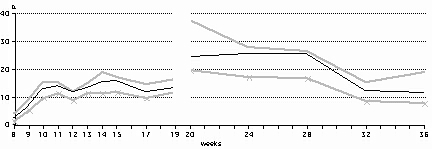Movements of the fetus, first evident at 8.5-9.5 weeks of gestation (see figure below), and young infant in which all parts of the body participate. They disappear from the behavioral repertoire some 4 months after birth in healthy fullterm infants to be replaced by more discrete movements giving the appearance of being under voluntary control. They vary in speed and amplitude, but lack a particular sequencing of body parts. Moreover, they give the impression of waxing and waning in intensity with gradual onsets and offsets. It has been suggested that they are an ontogenetic adaptation to prenatal life (e.g., through preventing stasis of the blood in the skin, adhesion of the fetes to the uterine wall).

General movements: they increase to about 15% of a one-hour observation time by 15 weeks and then to more than 20 % from 20-28 weeks, to return to about the level at 15 weeks toward the end of pregnancy. The black line stands for the median and the gray lines for the interquartile range. Figure adapted from de Vries, J.I.P., Visser, G.H.A., & Prechtl, H.F.R. (1985). The emergence of fetal behaviour. II. Quantitative aspects. Early Human Development, 15, 333-34 8 for 8 to 19 weeks, and from Roodenburg, P.J., Wladimiroff, J.W., van Es, A., & Prechtl, H.F.R. (1991). Classification and quantitative aspects of fatal movement during the second half of pregnancy. Early Human Development, 25, 19-35 for 20 to 36 weeks.
See Fetus, Fetal breathing movements, Hiccups, Ontogenetic adaptation, Startles, Stretches
